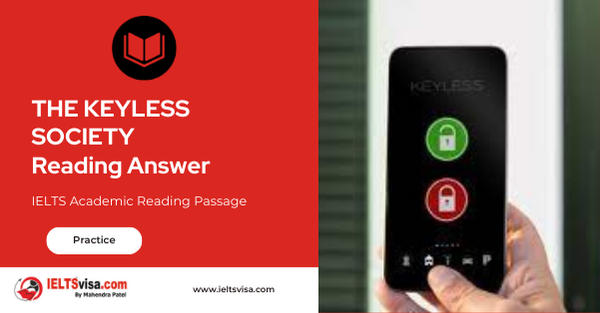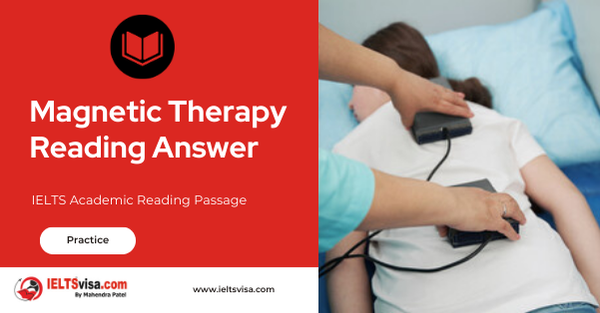THE KEYLESS SOCIETY Reading Answer
IELTS Academic Reading Passage
A
Students who want to enter the University of Montreal’s Athletic Complex need more than just a conventional ID card – their identities must be authenticated by an electronic hand scanner. In some California housing estates, a key alone is insufficient to get someone in the door; his or her voice print must also be verified. And soon, customers at some Japanese banks will have to present their faces for scanning before they can enter the building and withdraw their money.
B
All of these are applications of biometrics, a little-known but fast-growing technology that involves the use of physical or biological characteristics to identify individuals. In use for more than a decade at some high- security government institutions in the United States and Canada, biometrics are now rapidly popping up in the everyday world. Already, more than 10,000 facilities, from prisons to day-care centres, monitor people’s fingerprints or other physical parts to ensure that they are who they claim to be. Some 60 biometric companies around the world pulled in at least $22 million last year and that grand total is expected to mushroom to at least $50 million by 1999.
C
Biometric security systems operate by storing a digitised record of some unique human feature. When an authorised user wishes to enter or use the facility, the system scans the person’s corresponding characteristics and attempts to match them against those on record. Systems using fingerprints, hands, voices, irises, retinas and faces are already on the market. Others using typing patterns and even body odours are in various stages of development.
D
Fingerprint scanners are currently the most widely deployed type of biometric application, thanks to their growing use over the last 20 years by law-enforcement agencies. Sixteen American states now use biometric fingerprint verification systems to check that people claiming welfare payments are genuine. In June, politicians in Toronto voted to do the same, with a pilot project beginning next year.
E
To date, the most widely used commercial biometric system is the handkey, a type of hand scanner which reads the unique shape, size and irregularities of people’s hands. Originally developed for nuclear powerplants, the handkey received its big break when it was used to control access to the Olympic Village in Atlanta by more than 65,000 athletes, trainers and support staff Now there are scores of other applications.
F
Around the world, the market is growing rapidly. Malaysia, for example, is preparing to equip all of its airports with biometric face scanners to match passengers with luggage. And Japan’s largest maker of cash dispensers is developing new machines that incorporate iris scanners. The first commercial biometric, a hand reader used by an American firm to monitor employee attendance, was introduced in 1974. But only in the past few years has the technology improved enough for the prices to drop sufficiently to make them commercially viable. ‘When we started four years ago, I had to explain to everyone what a biometric is,’ says one marketing expert. Now, there’s much more awareness out there.’
G
Not surprisingly, biometrics raise thorny questions about privacy and the potential for abuse. Some worry that governments and industry will be tempted to use the technology to monitor individual behaviour. If someone used your fingerprints to match your health- insurance records with a credit-card record showing you regularly bought lots of cigarettes and fatty foods,’ says one policy analyst, ‘you would see your insurance payments go through the roof.’ In Toronto, critics of the welfare fingerprint plan complained that it would stigmatise recipients by forcing them to submit to a procedure widely identified with criminals.
H
Nonetheless, support for biometrics is growing in Toronto as it is in many other communities. In an increasingly crowded and complicated world, biometrics may well be a technology whose time has come.
Questions 1-7
Reading Passage 3 has eight paragraphs(A-H).
Choose the most suitable headings for paragraphsB-H from the list of headings below.
Write the appropriate numbers(i-x)in boxes1-7 on your answer sheet.
NBThere are more headings than paragraphs, so you will not use all of them.
| Example | Answer |
| Paragraph A | vi |
|
1 Paragraph B 2 Paragraph C 3 Paragraph D 4 Paragraph E 5 Paragraph F 6 Paragraph G 7 Paragraph H |
|
Questions 8-14
Look at the fallowing groups of people (Questions 8-14) and the list of biometric systems (A-F) below.
Match the groups of people to the biometric system associated with them in Reading Passage 3. Write the appropriate letters A-F in boxes 8-14 on your answer sheet.
NB You may use any biometric system more than once.
|
8 sports students 9 Olympic athletes 10 airline passengers 11 welfare claimants 12 business employees 13 home owners 14 bank customers |
|
||||||||||||||

Solution For: THE KEYLESS SOCIETY
Reading Answer
| 1. iv | 8. B |
| 2. vii | 9. B |
| 3. viii | 10. E |
| 4. iii | 11. A |
| 5. ii | 12. B |
| 6. i | 13. D |
| 7. x | 14. E |
Review and Practice
- Regularly practice with IELTS reading samples and time yourself to get used to the pressure of the exam.
- Review your mistakes to understand where you went wrong and how to avoid similar errors in the future.
Our Books
Master IELTS Speaking Part 1
IELTS Writing Task 1 Book
IELTS Writing Task 2 Book
THE KEYLESS SOCIETY Reading Answer Explanation
Comin Soon
Practice IELTS Other Modules
IELTS Listening
The IELTS Listening test assesses how well you can understand spoken English in various contexts. It lasts about 30 minutes and is divided into four sections with a total of 40 questions. The listening tasks become increasingly difficult as the test progresses.
IELTS Academic Reading
The IELTS Academic Reading section assesses your ability to understand and interpret a variety of texts in academic settings. It is designed to evaluate a range of reading skills, including skimming for gist, reading for main ideas, reading for detail, understanding inferences, and recognizing a writer's opinions and arguments.
IELTS Speaking
The IELTS Speaking test assesses your ability to communicate in English on everyday topics. It lasts 11-14 minutes and consists of three parts: introduction, cue card, and a discussion based on the cue card topic.
IELTS General Reading
IELTS General Reading tests your ability to understand and interpret various types of texts. Here are some key areas and types of content you can expect to encounter in the reading section, along with tips for effective preparation.
IELTS Academic Writing Task 1
In IELTS Academic Writing Task 1, you are presented with a visual representation of information, such as graphs, charts, tables, or diagrams, and you are required to summarize, compare, or explain the data in your own words.
IELTS General Writing Task 1
In IELTS General Writing Task 1, you are required to write a letter based on a given situation. The letter can be formal, semi-formal, or informal, depending on the prompt. Here’s a breakdown of the key components to include in your letter
IELTS Academic Writing Task 2
In IELTS Academic Writing Task 2, you are required to write an essay in response to a question or topic. Here’s a guide to help you understand the essential elements of this task
IELTS Exam Tips
To succeed in the IELTS exam, practice regularly, familiarize yourself with the test format, improve your vocabulary, develop time management skills, and take mock tests to build confidence.
Grammer for IELTS
Grammar is the foundation of effective communication in English. Understanding tense usage, subject-verb agreement, and sentence structure enhances clarity and coherence in writing and speaking.
Vocabulary for IELTS
Vocabulary plays a crucial role in the IELTS (International English Language Testing System) exam, especially in the Speaking and Writing sections. Here’s an overview of why vocabulary is important and how it impacts your performance
RECENT IELTS SAMPLES QUESTIONS AND ANSWERS
Becoming An Expert Reading Answer
A Expertise is commitment coupled with creativity. Specifically, it is the commitment of...
STUDY CENTRE COURSES Reading Answer
SELF-STUDY TIPS AHowever difficult you find it to arrange your time, it will pay off in the...
The Extrinct Grass In Britain Reading Answer
A The British grass interrupted brome was said to be extinct, just like the Dodo. Called...
Morse Code Reading Answer
A. A new satellite-based system is being implemented to replace Morse code for sending...
Magnetic Therapy Reading Answer
AMagnetic therapy, which is a $5-billion market worldwide, is a form of alternative medicine...
Lack Of Sleep Reading Answer
Section A It is estimated that the average man or woman needs between seven-and-a-half and...













